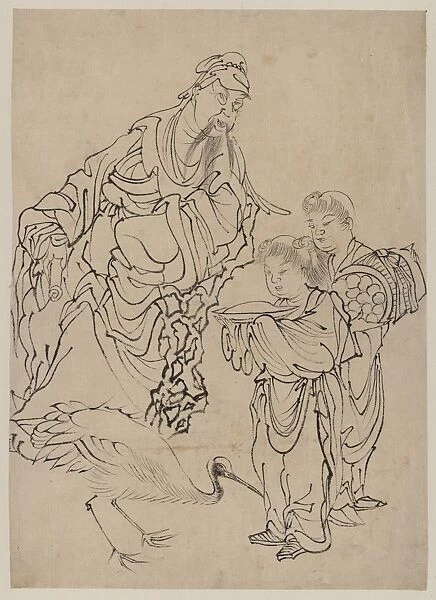Home > Animals > Birds > Rheas > Related Images
Rinnasei (Lin Hejing)
![]()

Wall Art and Photo Gifts from Mary Evans Picture Library
Rinnasei (Lin Hejing)
Rinnasei (Lin Hejing). Drawing shows a man with two children and a large bird, possibly a rhea. Date between 1830 and 1868
Mary Evans Picture Library makes available wonderful images created for people to enjoy over the centuries
Media ID 7371580
© Mary Evans Picture Library 2015 - https://copyrighthub.org/s0/hub1/creation/maryevans/MaryEvansPictureID/10604603
FEATURES IN THESE COLLECTIONS
> Animals
> Birds
> Rheas
> Related Images
> Asia
> Japan
> Related Images
EDITORS COMMENTS
This woodblock print, titled "Rinnasei (Lin Hejing) with Two Children and a Rhea," showcases the artistic mastery of Japanese woodblock printing during the mid-19th century. The image features a man, believed to be Lin Hejing, a Chinese scholar and diplomat who served as the Chinese envoy to Japan between 1832 and 1834. He is depicted in traditional Chinese attire, sitting on a mat with two children playing at his feet. The serene expression on his face conveys wisdom and tranquility. The most striking element of the print is the large rhea bird perched beside Lin Hejing. This South American bird, an exotic addition to the Japanese landscape, adds a sense of adventure and discovery to the scene. The intricate details of the rhea's feathers, eyes, and beak are rendered with remarkable precision, showcasing the skill and artistry of the woodblock printer. The background of the print is filled with lush greenery and delicate flowers, creating a harmonious balance between the natural world and the human presence. The use of bold lines, vibrant colors, and intricate patterns is characteristic of the ukiyo-e style, which flourished in Japan during the Edo period. The date of this print is estimated to be between 1830 and 1868, making it an invaluable piece of Japanese art history. The print is a testament to the cultural exchange between China and Japan during this period, as well as the artistic innovation and creativity that emerged from their interaction.
MADE IN AUSTRALIA
Safe Shipping with 30 Day Money Back Guarantee
FREE PERSONALISATION*
We are proud to offer a range of customisation features including Personalised Captions, Color Filters and Picture Zoom Tools
SECURE PAYMENTS
We happily accept a wide range of payment options so you can pay for the things you need in the way that is most convenient for you
* Options may vary by product and licensing agreement. Zoomed Pictures can be adjusted in the Cart.



